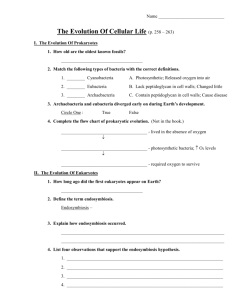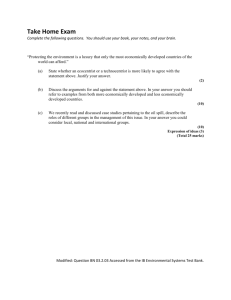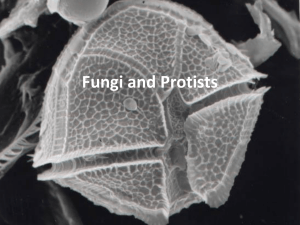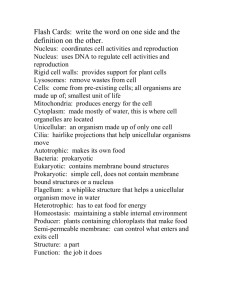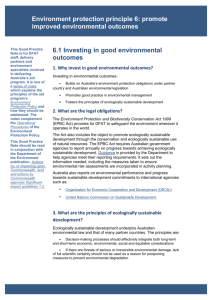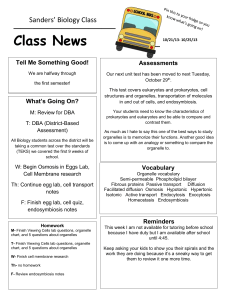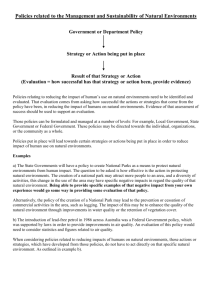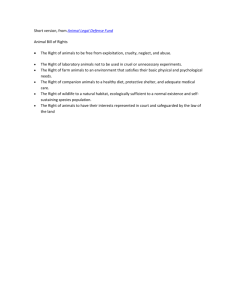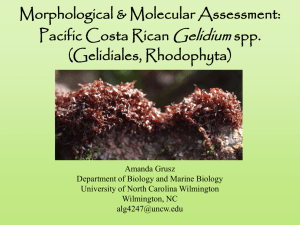AG V03 Plant Biology Lecture: The Protists (Ch 21)
advertisement
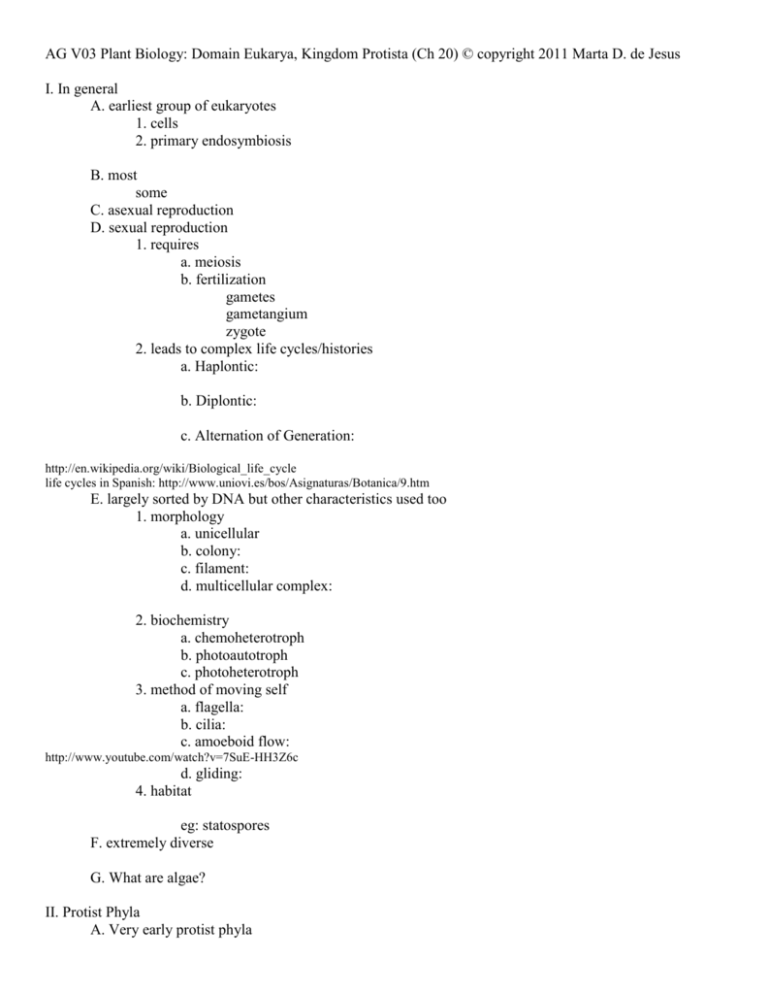
AG V03 Plant Biology: Domain Eukarya, Kingdom Protista (Ch 20) © copyright 2011 Marta D. de Jesus I. In general A. earliest group of eukaryotes 1. cells 2. primary endosymbiosis B. most some C. asexual reproduction D. sexual reproduction 1. requires a. meiosis b. fertilization gametes gametangium zygote 2. leads to complex life cycles/histories a. Haplontic: b. Diplontic: c. Alternation of Generation: http://en.wikipedia.org/wiki/Biological_life_cycle life cycles in Spanish: http://www.uniovi.es/bos/Asignaturas/Botanica/9.htm E. largely sorted by DNA but other characteristics used too 1. morphology a. unicellular b. colony: c. filament: d. multicellular complex: 2. biochemistry a. chemoheterotroph b. photoautotroph c. photoheterotroph 3. method of moving self a. flagella: b. cilia: c. amoeboid flow: http://www.youtube.com/watch?v=7SuE-HH3Z6c d. gliding: 4. habitat eg: statospores F. extremely diverse G. What are algae? II. Protist Phyla A. Very early protist phyla B. P: Euglenophyta/Euglenozoa 1. 2. 3. 4. 5. secondary endosymbiosis 6. eyespot 7. pellicle 8. 9. reproduce eg: Euglena Phacus C. P: Dinophyta = Pyrrophyta 1. 2. 3. 4. secondary endosymbiosis 5. “grass of the sea” 6. bloom 7. toxins 8. bioluminesce eg: Akishiwo sanguinea Alexandrium catenella Ceratium Gonyaulax/Lingulodinium D. P: Oomycota 1. 2. 3. Saprolegnia diplontic LC 4. Phytophthora infestans = late blight of potato 5. Plasmopara viticola = downy mildew of grapes http://www.botany.hawaii.edu/faculty/wong/BOT135/LECT06.HTM E. P: Chromophyta heterokonts 1. C: Xanthophyceae a. b. c. Oomycota eg: Vaucheria, Stipitococcus http://silicasecchidisk.conncoll.edu/LucidKeys/Carolina_Key/html/Vaucheria_Reproduction.html 2. C: Chrysophyceae a. b. c. statospores eg: Dinobryon (in wrong class in chapter) 3. C: Bacillariophyceae eg: Cymatopleura a. grass of the sea b. c. unusual cell walls 2 shapes centric pennate d. unusual diplontic LC e. economically diatomaceaous earth f. g. Chaetoceros h. Pseudonitzschia 4. C: Phaeophyceae eg: Fucus LC atypical most a. b. kelps c. d. ecologically important eg: Macrocystis Nereocystis, Sargassum Lobophora e. economically important: algin(ate) f. Undaria = wakame F. P: Prymnesiophyta = haptophytes eg: Emiliana 1. 2. haptonema 3. “grass of the sea” coccolithophores 4. G. P: Cryptophyta eg: Cryptomonas 1. 2. 3. 4. 5. evolutionary step nucleomorph H. SubK: Viridiplantae 1. P: Rhodophyta eg: Botryocladia, Stenogramme, Gigartina, Gelidium a. b. c. complicated alternation of generation life cycles eg: Polysiphonia LC d. ecologically important e. economically important: 1) eg: Gelidium spp Chondrus crispus = Irish moss Gloiopeltis = funori 2) eg: Porphyra = nori Palmaria palmata = dulse 3) 2. P: Chlorophyta a. b. unicellular eg: Chlamydomonas Chlorella Micromonas c. colonial eg: Volvox Pediastrum Scenedesmus Hydrodictyon d. filamentous eg: Ulothrix Oedogonium e. multicellular forms eg: Acetabularia = mermaids’ wine glass green seaweeds eg: Ulva Cladophora f. g. h. ecologically i. economically 3. P: Charophyta = stoneworts eg: Chara (some of these species are in wrong phylum in chapter) a. b. c. d. haplontic LC eg: Spirogyra e. unicellular eg: desmids - Closterium, Micrasterias f. filamentous Spirogyra g. multicellular forms - these led to land plants eg: Coleochaete I. P: Myxomycota = plasmodial slime molds 1. 2. diplontic LC 3. 4. 5. 6. plasmodium eg: Physarum 7. sporangia eg: Lamproderma, Lycolgala, Stemonitis http://cchsbio.blogspot.com/2008/01/plasmodial-slime-mold-video.html (first ~50sec) J. P: Dictyosteliomycota = cellular slime molds eg: Dictyostelium 1. 2. 3. slug 4. http://www.youtube.com/watch?v=VWGA7kIeE0Q
